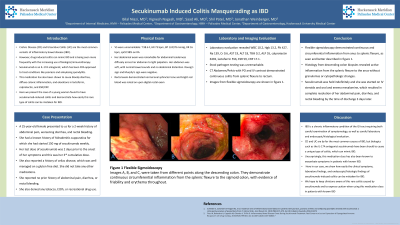Monday Poster Session
Category: Colon
P1712 - Secukinumab Induced Colitis Masquerading as IBD
Monday, October 23, 2023
10:30 AM - 4:15 PM PT
Location: Exhibit Hall

Has Audio
.jpeg.jpg)
Bilal Niazi, MD
HMH - Palisades Medical Center
North Bergen, NJ
Presenting Author(s)
Bilal Niazi, MD1, Vignesh Krishnan, MD1, Saad Ali, MD1, Shil Patel, MD2, Jonathan Weinberger, MD2
1HMH - Palisades Medical Center, North Bergen, NJ; 2Hackensack University Medical Center, Hackensack, NJ
Introduction: Crohns disease (CD) and Ulcerative Colitis (UC) are the most common variants of inflammatory bowel disease (IBD). However, drug-induced colitis is being seen more frequently with the increasing use of biologics/immunotherapy. Secukinumab has been shown to cause bloody diarrhea with diffuse colonic inflammation, elevations in lactoferrin, calprotectin, and ESR/CRP. Here we present a young woman with bloody diarrhea found to have features of IBD attributed to Secukinumab therapy. We hope to increase awareness of secukinumab induced colitis as an IBD-mimicker.
Case Description/Methods: A 25-year-old female presented for a 2 week history of abdominal pain, worsening diarrhea, and rectal bleeding. She had a history of hidradenitis suppurativa treated with weekly secukinunamab 150mg. Her last dose was 2 days prior to onset of symptoms, and it was her 3rd cumulative dose. She had a history of celiac disease, well managed on a gluten free diet and did not take any other medications. Denied tobacco, EtOh, or recreational drug use.
VS were unremarkable and she did not appear in any acute distress. His physical exam was remarkable for abdominal tenderness. Laboratory evaluation revealed Hgb 13.2, Plt 427, Na 139, Cr 0.6, AST 19, ALT 18, TBili 0.2, ALP 55, calprotectin 6392, lactoferrin 556, ESR 59, CRP 17.1. Stool pathogen testing was unremarkable. CT imaging demonstrated continuous colitis from splenic flexure to rectum. Flexible sigmoidoscopy demonstrated continuous and circumferential inflammation from anus to splenic flexure, as seen in figure 1. Pathology from sigmoidoscopy revealed active inflammation from splenic flexure to anus without granulomas or cytopathologic changes. Secukinumab remained held. She was started on IV steroids and oral and enema mesalamine with complete resolution of abdominal pain, diarrhea, and rectal bleeding by the time of discharge 3 days later.
Discussion: IBD is a chronic inflammatory condition of the GI tract requiring a careful examination of symptomology, as well as laboratory and endoscopic/histological evaluation. CD and UC are by far the most common causes of IBD, but drugs such as Secukinumab can present with colitis mimicking IBD. By presenting our case we hope to illustrate how secukinumab-induced colitis can mimic IBD and to increase awareness of this potential adverse effect of secukinumab therapy.

Disclosures:
Bilal Niazi, MD1, Vignesh Krishnan, MD1, Saad Ali, MD1, Shil Patel, MD2, Jonathan Weinberger, MD2. P1712 - Secukinumab Induced Colitis Masquerading as IBD, ACG 2023 Annual Scientific Meeting Abstracts. Vancouver, BC, Canada: American College of Gastroenterology.
1HMH - Palisades Medical Center, North Bergen, NJ; 2Hackensack University Medical Center, Hackensack, NJ
Introduction: Crohns disease (CD) and Ulcerative Colitis (UC) are the most common variants of inflammatory bowel disease (IBD). However, drug-induced colitis is being seen more frequently with the increasing use of biologics/immunotherapy. Secukinumab has been shown to cause bloody diarrhea with diffuse colonic inflammation, elevations in lactoferrin, calprotectin, and ESR/CRP. Here we present a young woman with bloody diarrhea found to have features of IBD attributed to Secukinumab therapy. We hope to increase awareness of secukinumab induced colitis as an IBD-mimicker.
Case Description/Methods: A 25-year-old female presented for a 2 week history of abdominal pain, worsening diarrhea, and rectal bleeding. She had a history of hidradenitis suppurativa treated with weekly secukinunamab 150mg. Her last dose was 2 days prior to onset of symptoms, and it was her 3rd cumulative dose. She had a history of celiac disease, well managed on a gluten free diet and did not take any other medications. Denied tobacco, EtOh, or recreational drug use.
VS were unremarkable and she did not appear in any acute distress. His physical exam was remarkable for abdominal tenderness. Laboratory evaluation revealed Hgb 13.2, Plt 427, Na 139, Cr 0.6, AST 19, ALT 18, TBili 0.2, ALP 55, calprotectin 6392, lactoferrin 556, ESR 59, CRP 17.1. Stool pathogen testing was unremarkable. CT imaging demonstrated continuous colitis from splenic flexure to rectum. Flexible sigmoidoscopy demonstrated continuous and circumferential inflammation from anus to splenic flexure, as seen in figure 1. Pathology from sigmoidoscopy revealed active inflammation from splenic flexure to anus without granulomas or cytopathologic changes. Secukinumab remained held. She was started on IV steroids and oral and enema mesalamine with complete resolution of abdominal pain, diarrhea, and rectal bleeding by the time of discharge 3 days later.
Discussion: IBD is a chronic inflammatory condition of the GI tract requiring a careful examination of symptomology, as well as laboratory and endoscopic/histological evaluation. CD and UC are by far the most common causes of IBD, but drugs such as Secukinumab can present with colitis mimicking IBD. By presenting our case we hope to illustrate how secukinumab-induced colitis can mimic IBD and to increase awareness of this potential adverse effect of secukinumab therapy.

Figure: Here we can visualize the continuous erythema and friability from the anus (Fig1.A) through the descending colon (Fig1.B). In Fig1.C, we are able to visual circumferential involvement of inflammation in the descending colon.
Disclosures:
Bilal Niazi indicated no relevant financial relationships.
Vignesh Krishnan indicated no relevant financial relationships.
Saad Ali indicated no relevant financial relationships.
Shil Patel indicated no relevant financial relationships.
Jonathan Weinberger indicated no relevant financial relationships.
Bilal Niazi, MD1, Vignesh Krishnan, MD1, Saad Ali, MD1, Shil Patel, MD2, Jonathan Weinberger, MD2. P1712 - Secukinumab Induced Colitis Masquerading as IBD, ACG 2023 Annual Scientific Meeting Abstracts. Vancouver, BC, Canada: American College of Gastroenterology.

